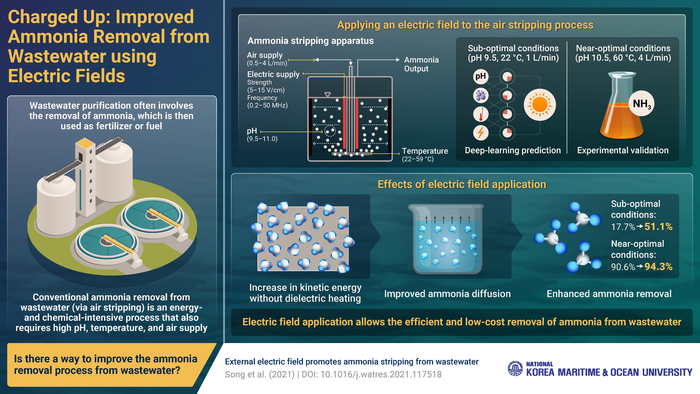Ammonia is one of many pollutants present in wastewater and can be toxic for marine and terrestrial life. Therefore, in a process called air stripping, it is removed from wastewater and later used as a fertilizer or fuel. Air stripping converts ammonia into a gas, that can then escape the wastewater from its surface. But this process is not efficient: it is energy-intensive, and requires specific temperatures, air supply, and a lot of chemicals, making it expensive.

Credit: National Korea Maritime & Ocean University
Ammonia is one of many pollutants present in wastewater and can be toxic for marine and terrestrial life. Therefore, in a process called air stripping, it is removed from wastewater and later used as a fertilizer or fuel. Air stripping converts ammonia into a gas, that can then escape the wastewater from its surface. But this process is not efficient: it is energy-intensive, and requires specific temperatures, air supply, and a lot of chemicals, making it expensive.
Addressing these drawbacks, in a study published in Water Research (made available online on August 5, 2021 and published in Volume 203 of the journal on September 15, 2021), researchers from South Korea have demonstrated that the simple application of an electric field during air stripping can substantially improve the efficiency of ammonia removal, even under sub-optimal conditions. “So far, the removal of ammonia from wastewater was thought to be dependent on only pH, temperature, and air supply. However, we have shown that an electrical field can also act as a modulator of this process,” says Prof. Young-Chae Song, the lead investigator on this study.
Prof. Song and his team used a combination of live experiments with an ammonia stripping tank and deep learning to understand how electric fields of different strengths influence the efficiency of ammonia removal from wastewater. They found that electric fields with an alternating current of 50 MHz and a power of 15 V/cm significantly improves the ammonia removal efficiency, increasing it from 51% to 94%, even under sub-optimal conditions. Therefore, improved ammonia yields could be achieved while considerably reducing the consumption of energy and chemicals.
Prof. Song comments, “Our simulations showed that electric field application provides a similar efficiency of ammonia removal to conventional methods at a much lower temperature, air supply, and pH. Moreover, the energy needed to power the electric field is a minute fraction of the energy required to achieve these ‘optimal’ conditions.”
Indeed, this new electric field-coupled platform could provide a more economical way of stripping ammonia from wastewater and reducing the carbon footprint associated with this process.
***
Reference
Authors: Young-Chae Song1,2, Jung-Hui Woo3, Gyung-Geun Oh1, Dong-Hoon Kim4, Chae-Young Lee5, Hyun-Woo Kim6
DOI: https://doi.org/10.1016/j.watres.2021.117518
Affiliations:
1 Department of Environmental Engineering, Korea Maritime and Ocean University, Busan 49112, South Korea
2 Interdisciplinary Major of Ocean Renewable Energy Engineering, Korea Maritime and Ocean University, Busan 49112, South Korea
3 Nuclear Power Equipment Research Center, Korea Maritime and Ocean University, Busan 49112, Korea
4 Department of Civil Engineering, Inha University, Incheon 22212, South Korea
5 Department of Civil and Environmental Engineering, The University of Suwon, Gyeonggi-do 18323, South Korea
6 Department of Environmental Engineering, Jeonbuk National University, Jeonbuk 54896, South Korea
About National Korea Maritime & Ocean University
South Korea’s most prestigious university for maritime studies, transportation science, and engineering, the National Korea Maritime & Ocean University is located on an island in Busan. The university was established in 1945 and since then has merged with other universities to currently being the only post-secondary institution that specializes in maritime sciences and engineering. It has four colleges that offer both undergraduate and graduate courses.
Website: http://www.kmou.ac.kr/english/main.do
About Prof. Young-Chae Song
Prof. Young-Chae Song is a full professor in the Department of Environmental Engineering, Korea Maritime and Ocean University. He received his PhD in Environmental Engineering from the Korea Advanced Institute of Science and Technology in 1995. His research attempts to solve environmental problems by integrating electrochemistry with existing physicochemical and biological technologies. The main focus areas of his research include anaerobic digestion, improvements in anaerobic digestion performance using bioelectrochemistry, sensing technology for real-time monitoring and early warning, and automated control using artificial intelligence.
Journal
Water Research
DOI
10.1016/j.watres.2021.117518
Method of Research
Experimental study
Subject of Research
Not applicable
Article Title
External electric field promotes ammonia stripping from wastewater
Article Publication Date
15-Sep-2021
COI Statement
None




